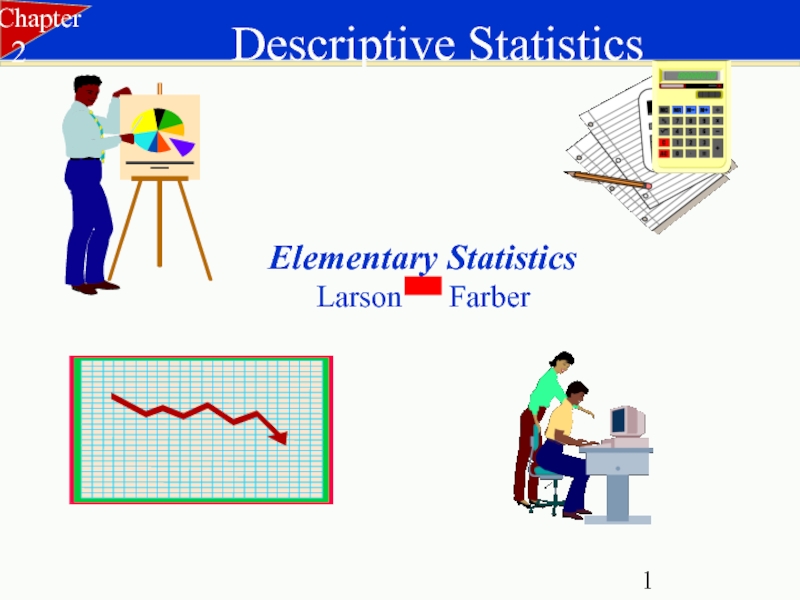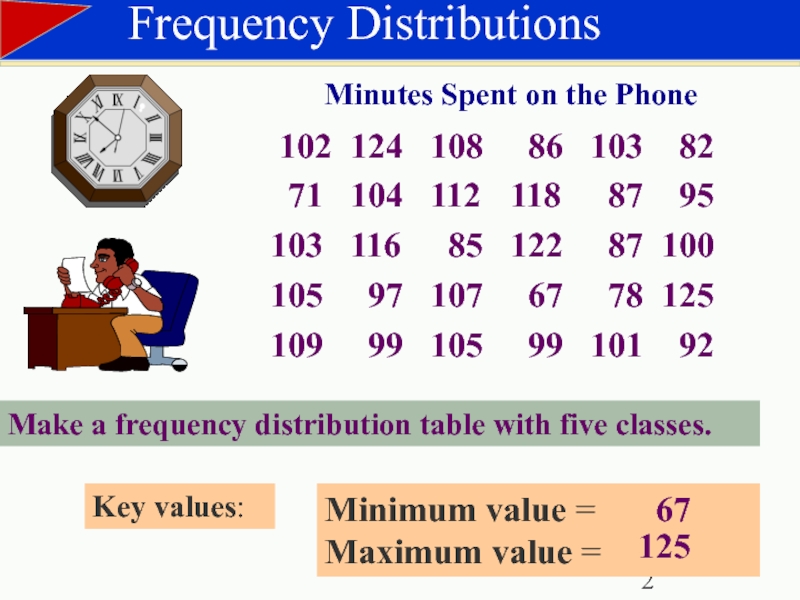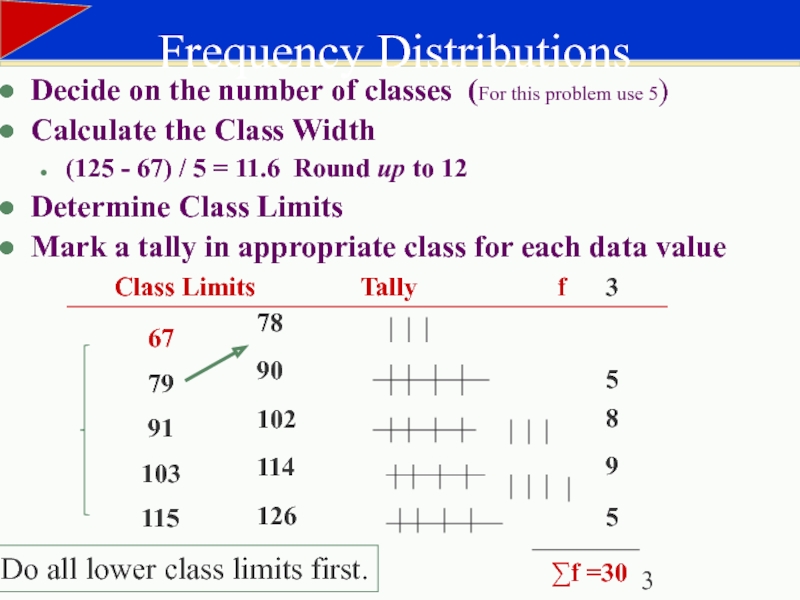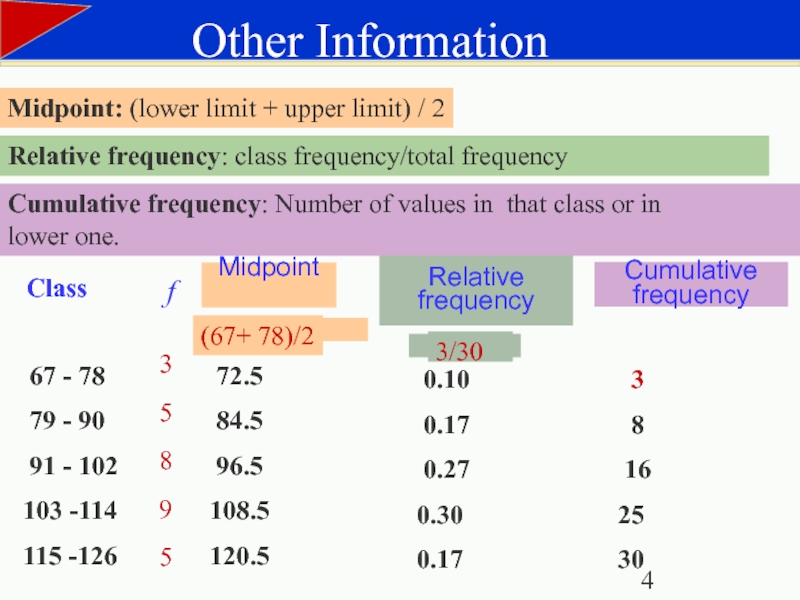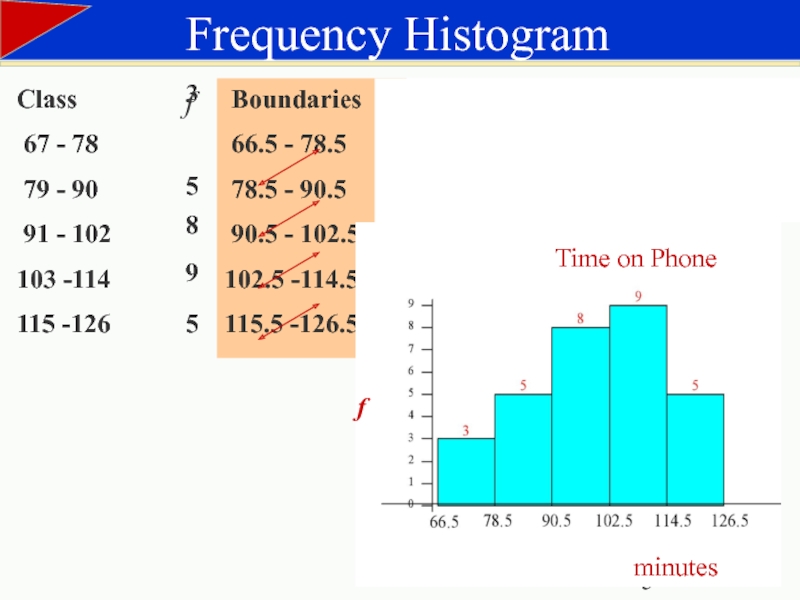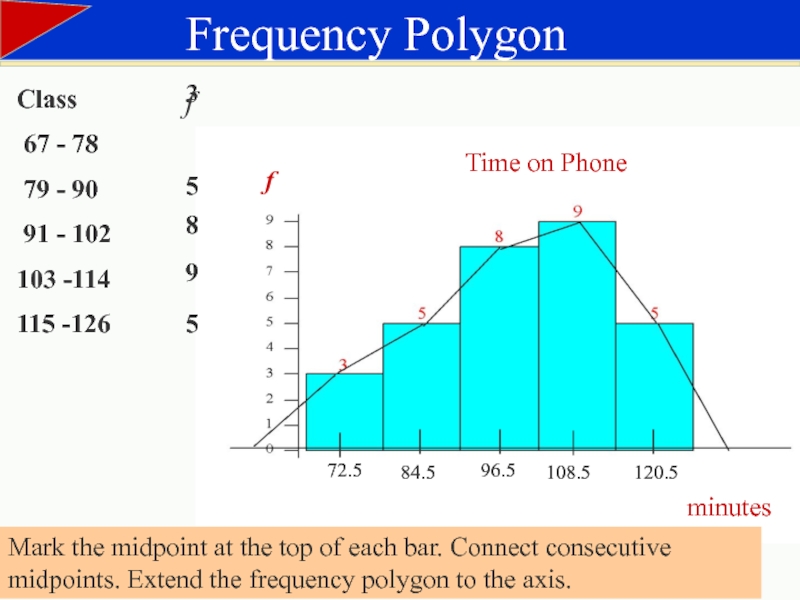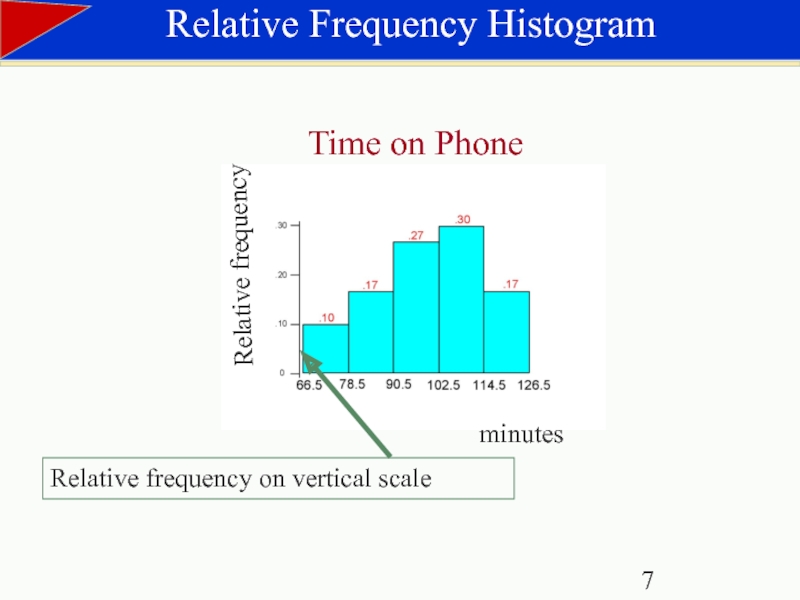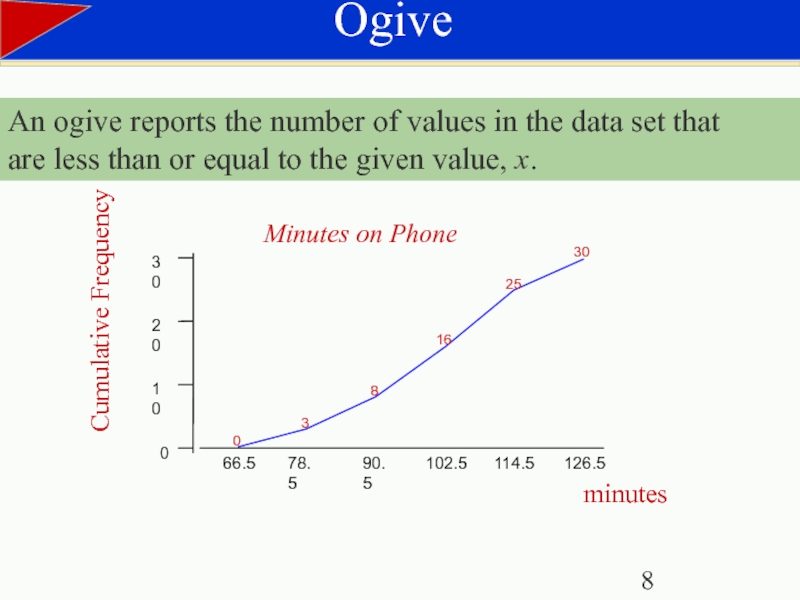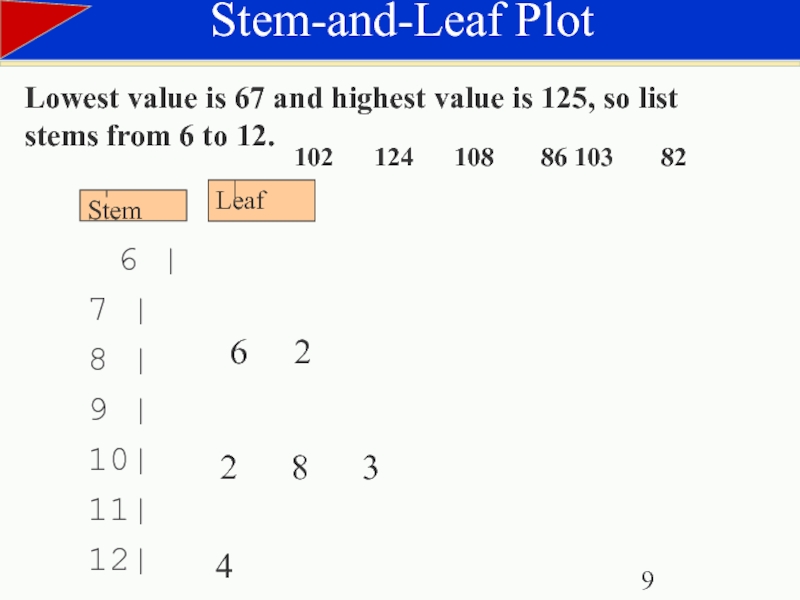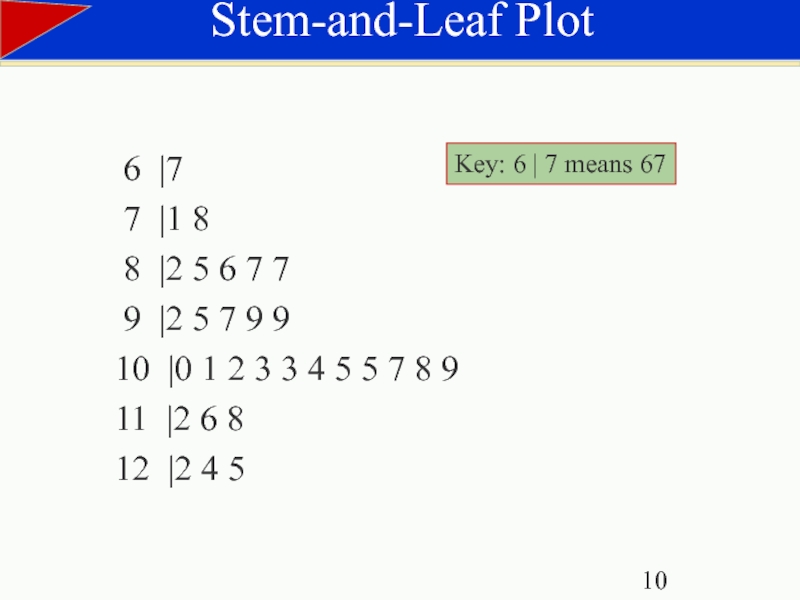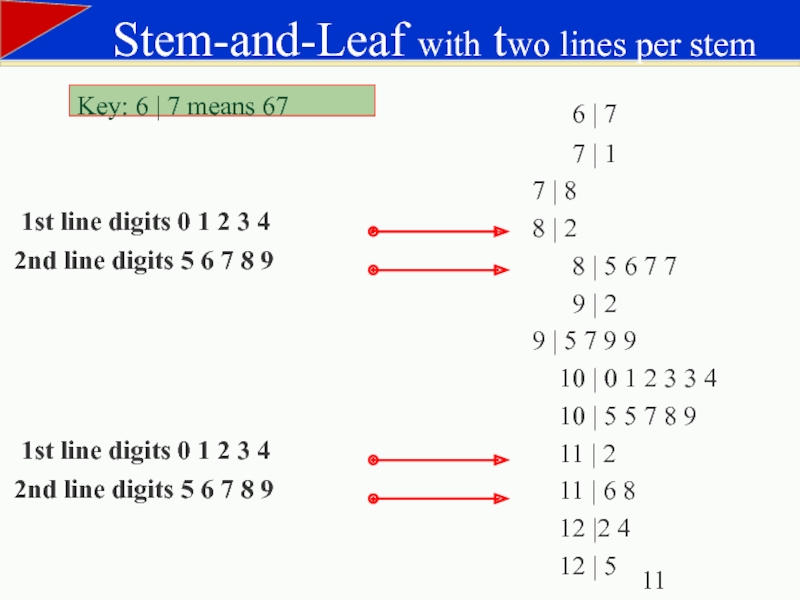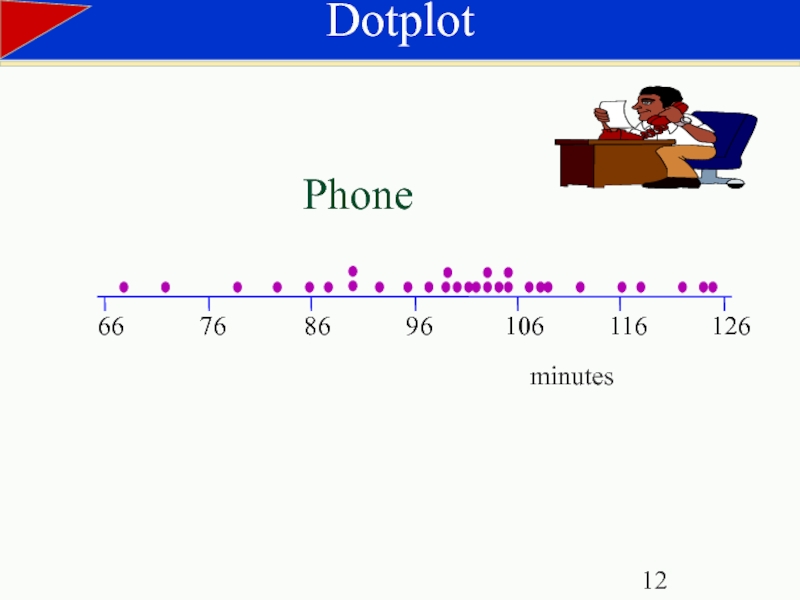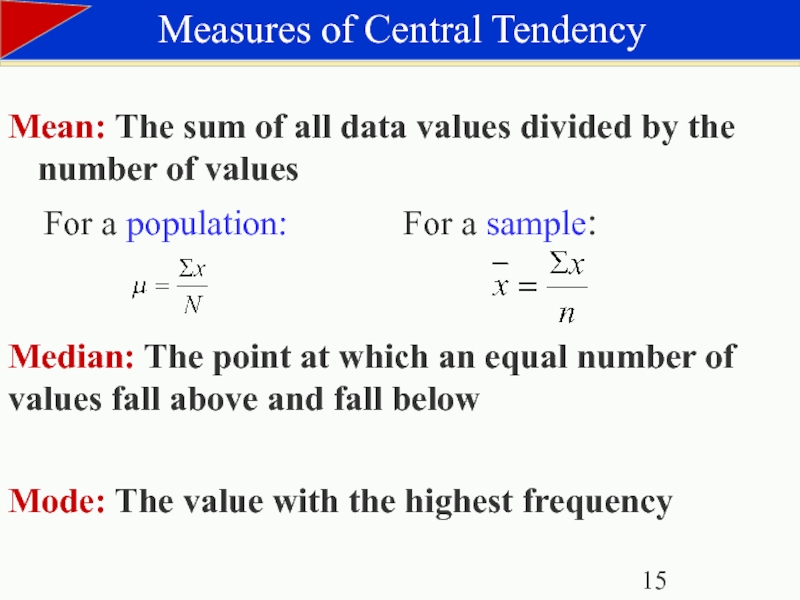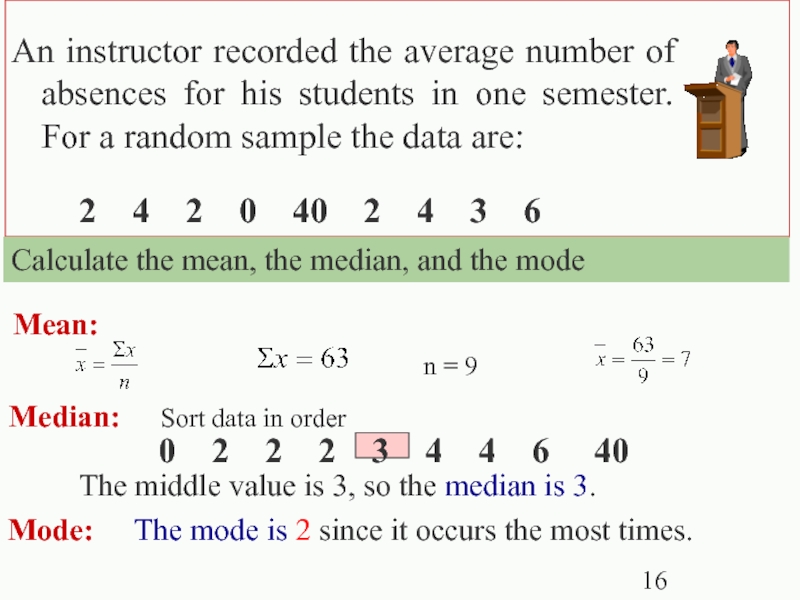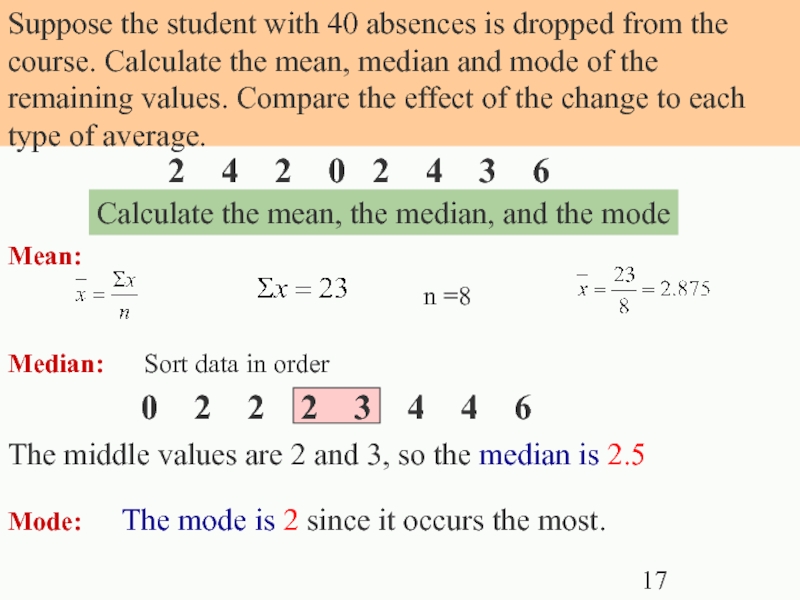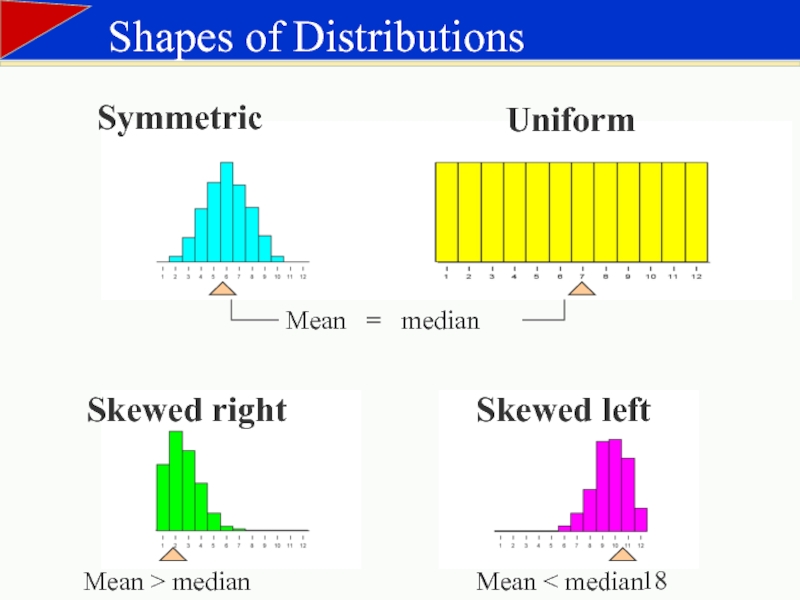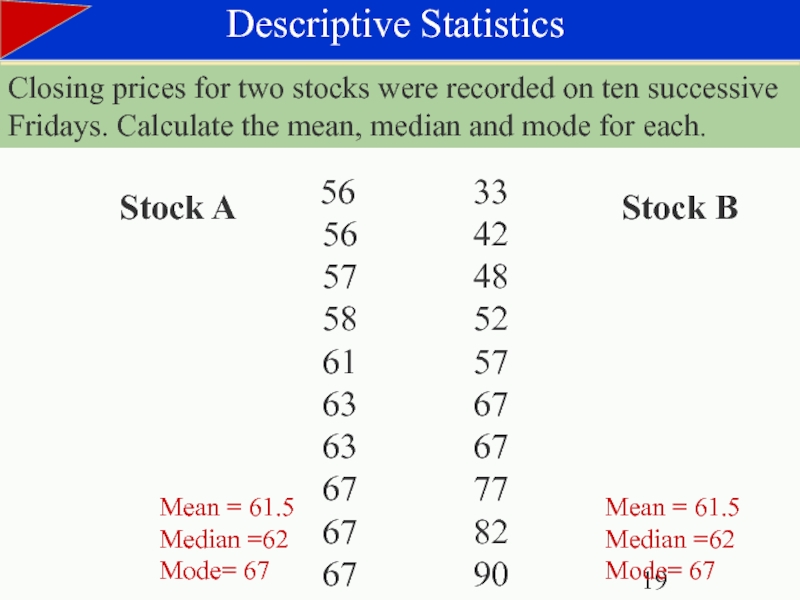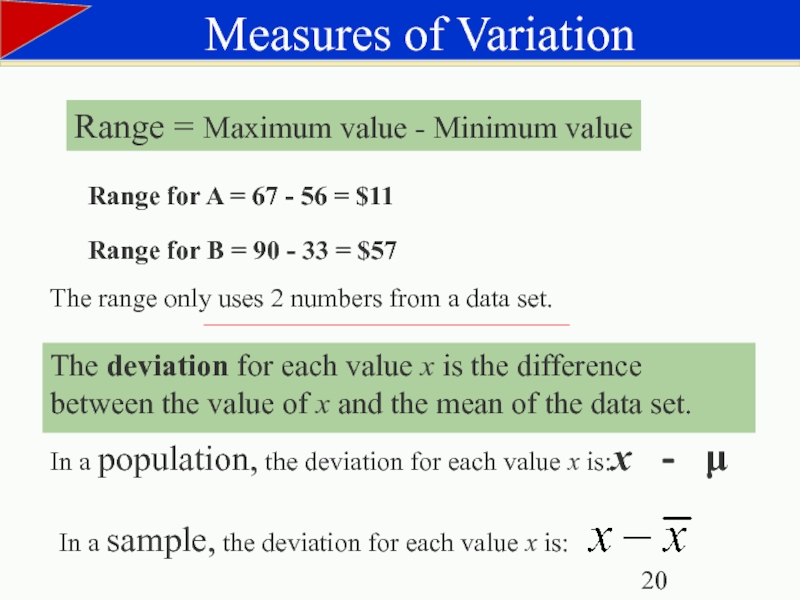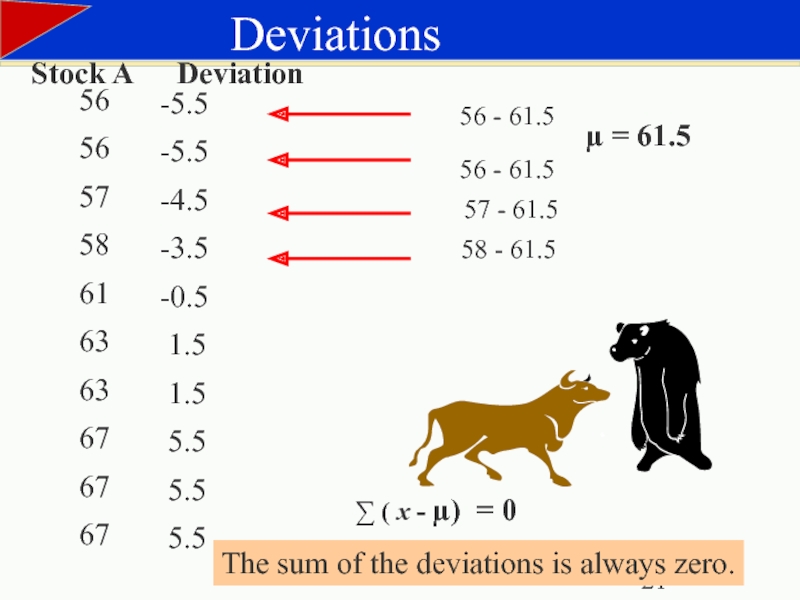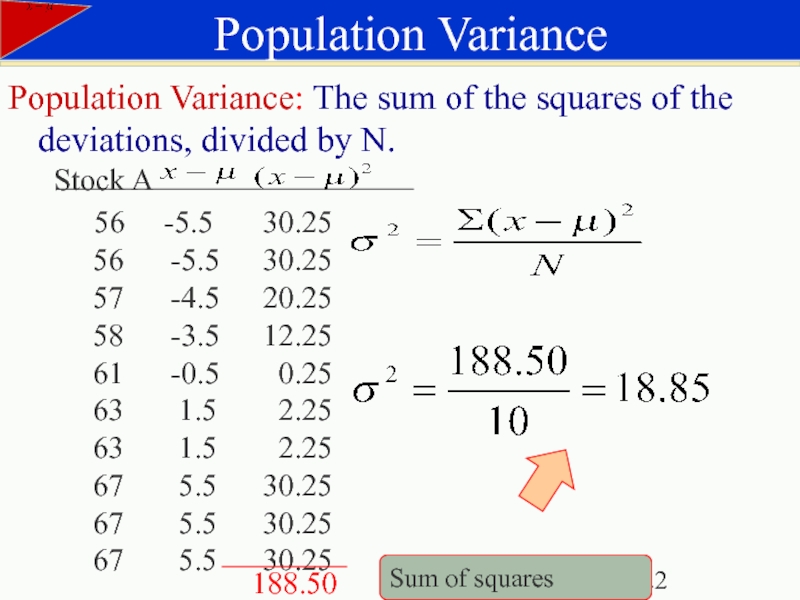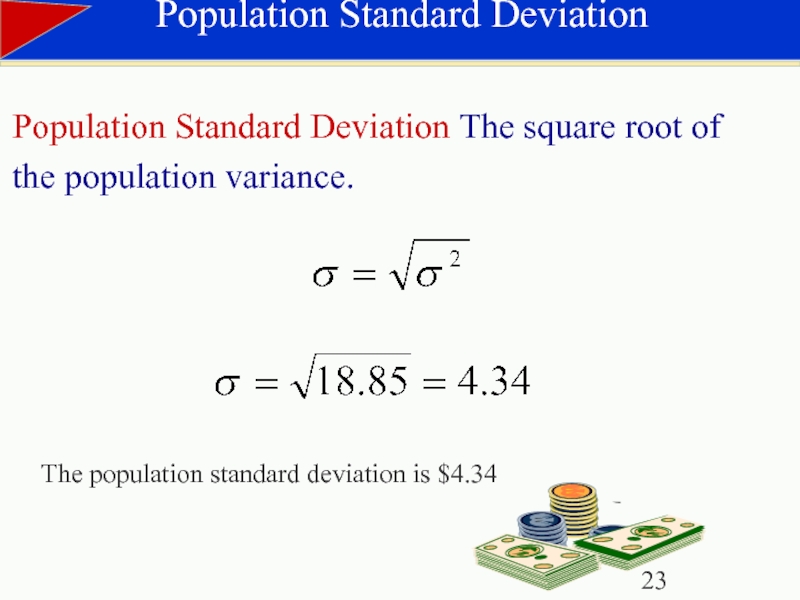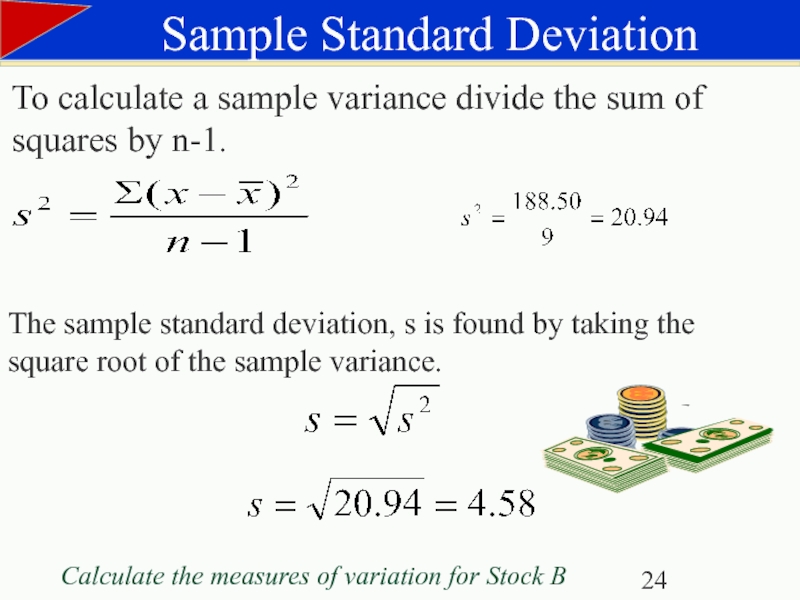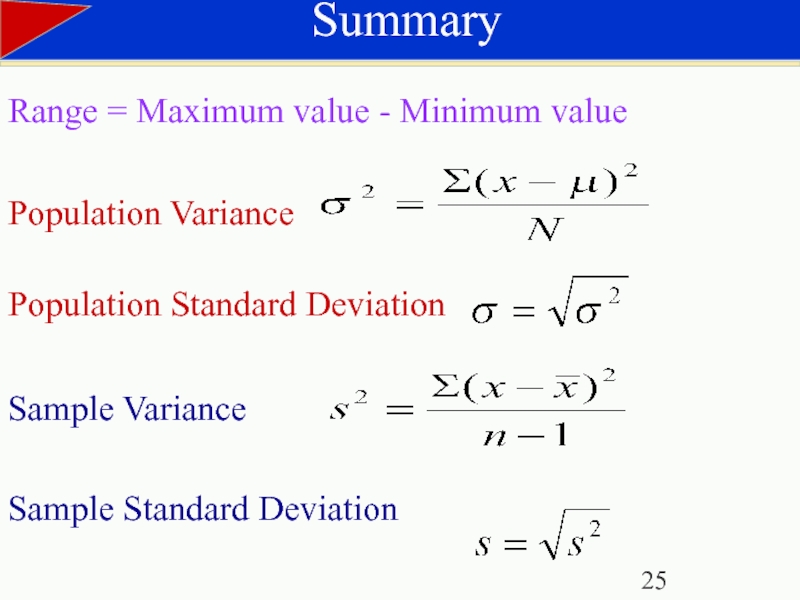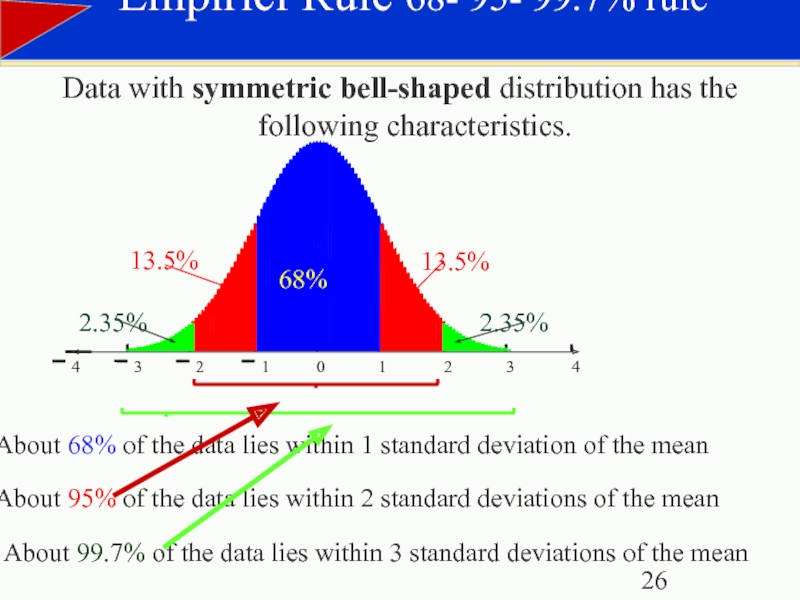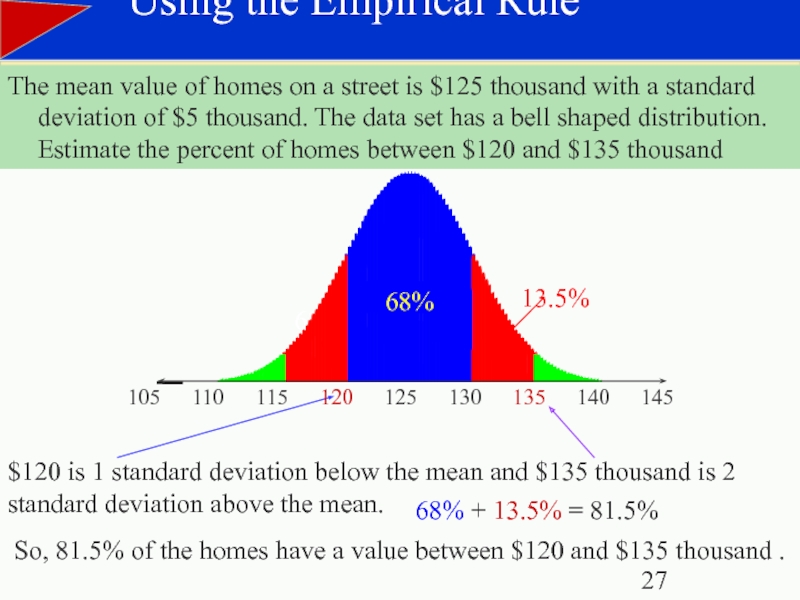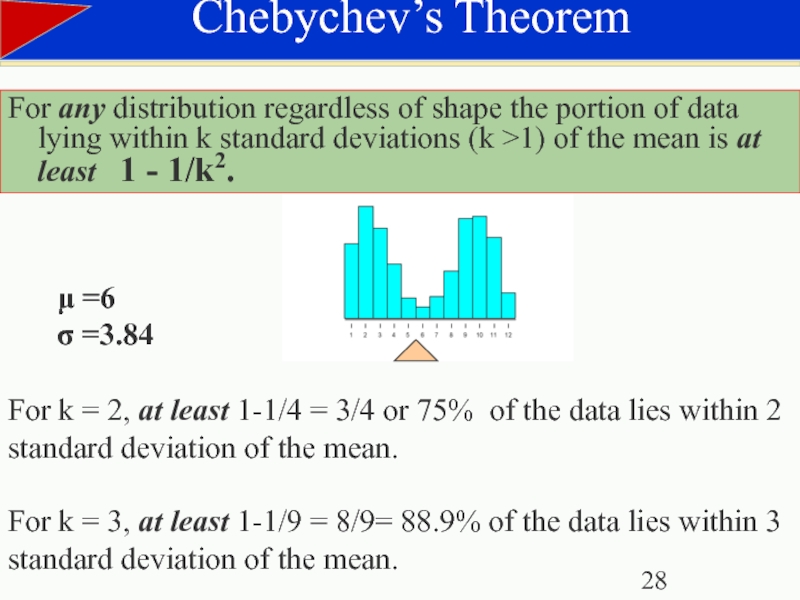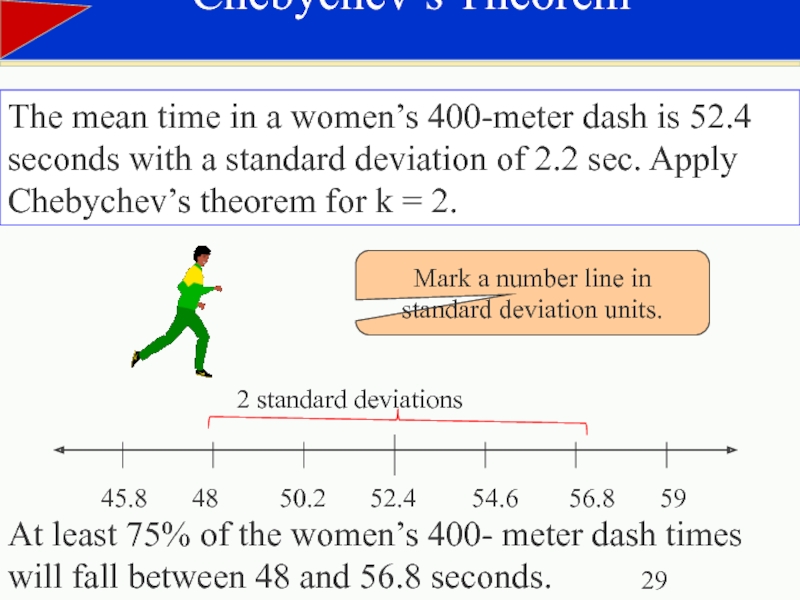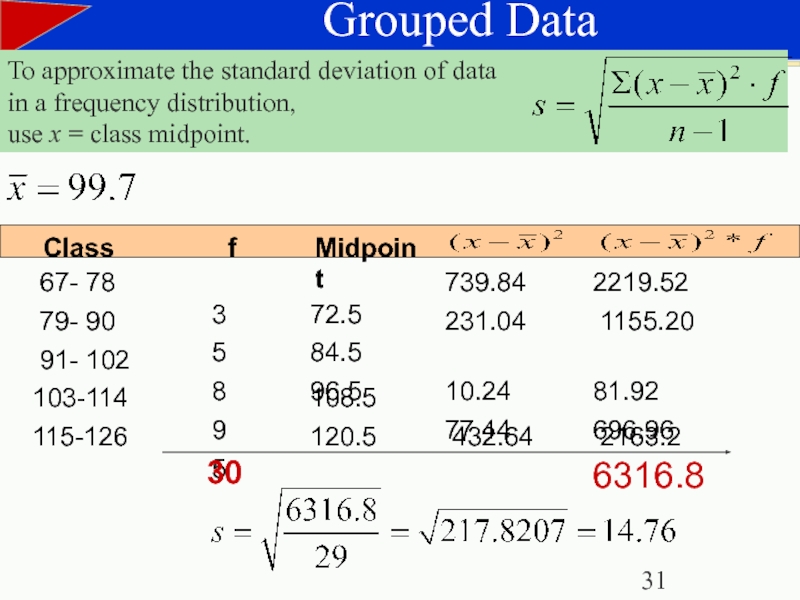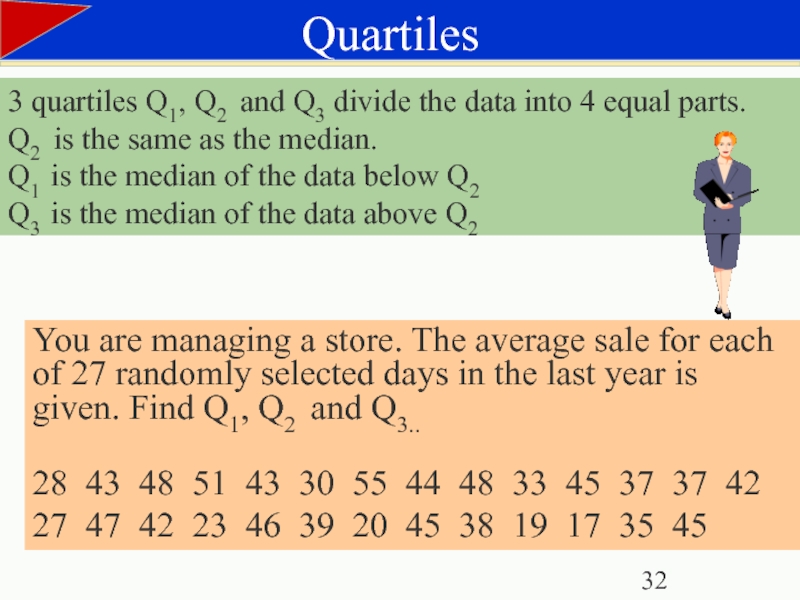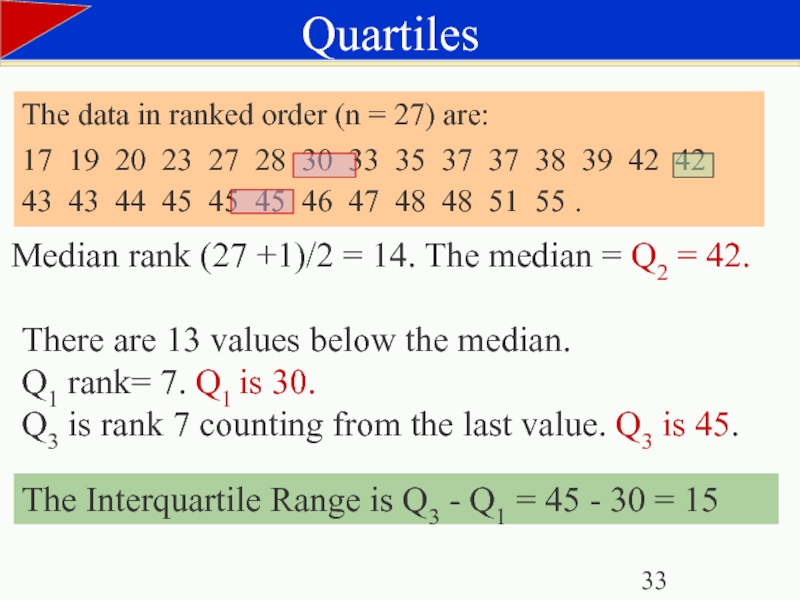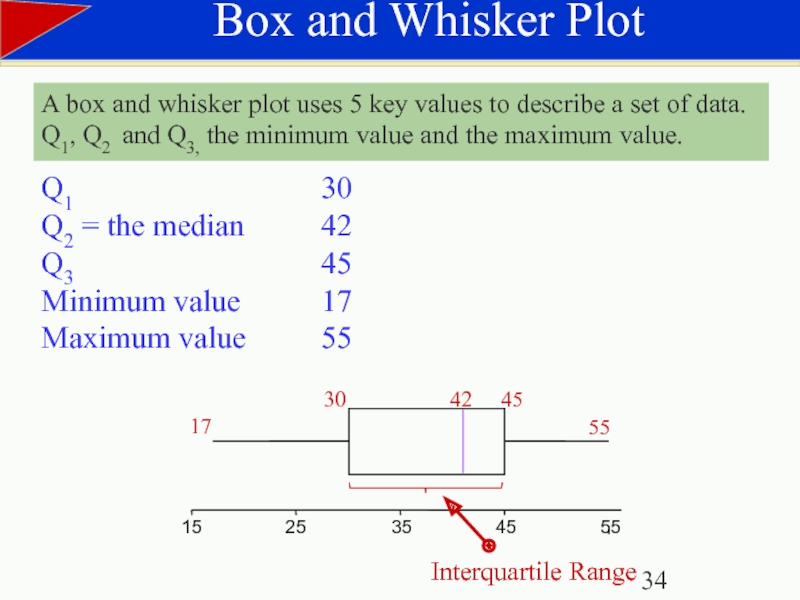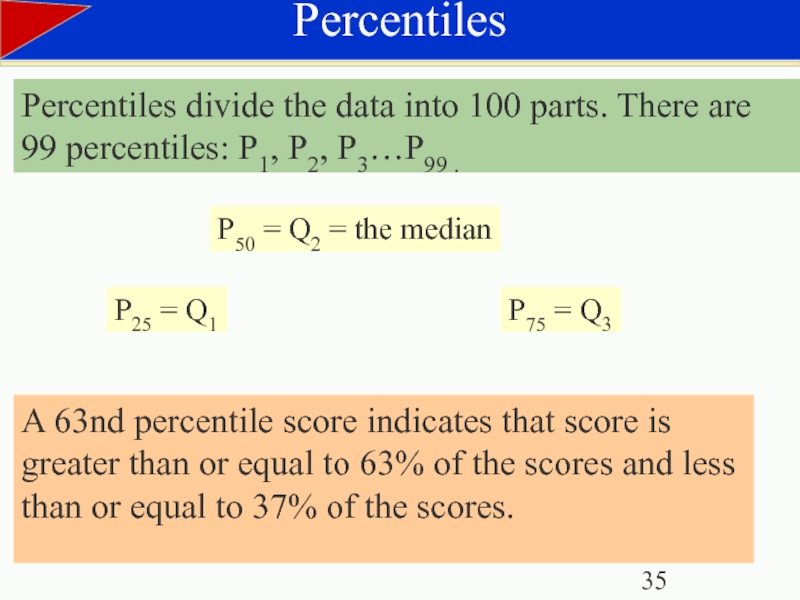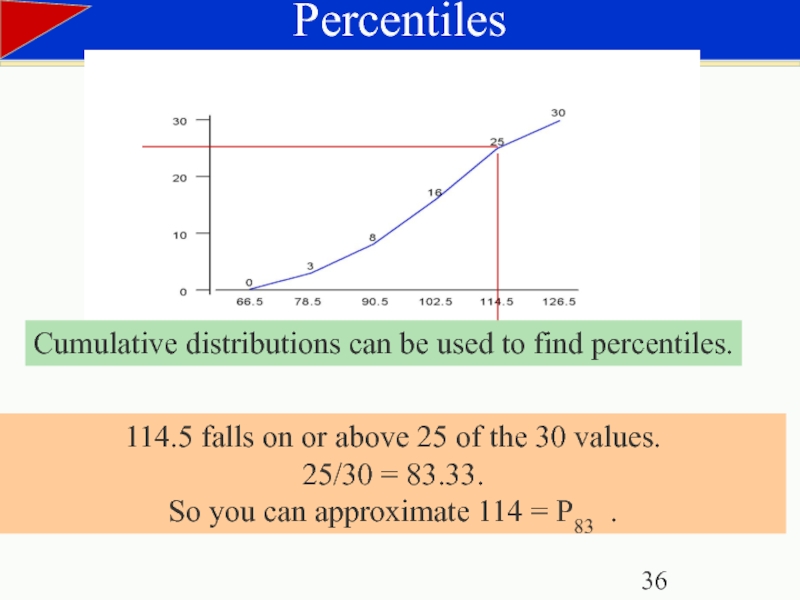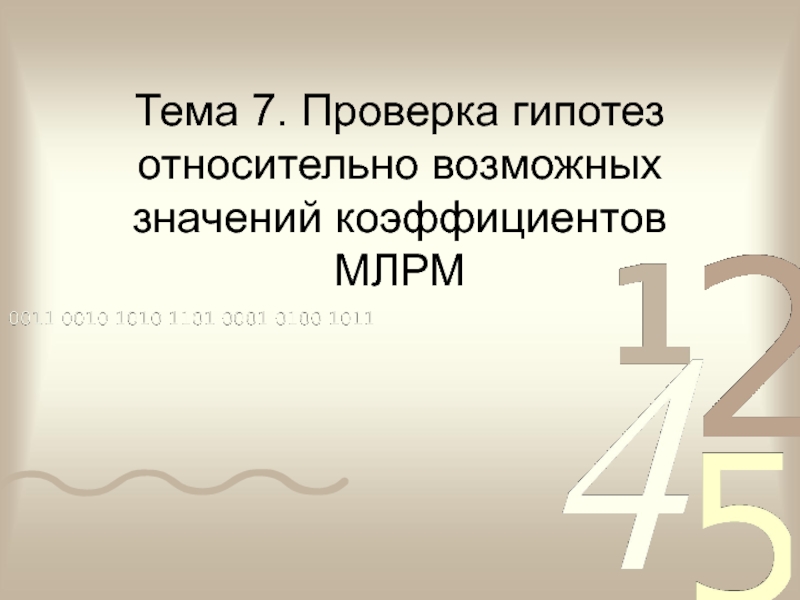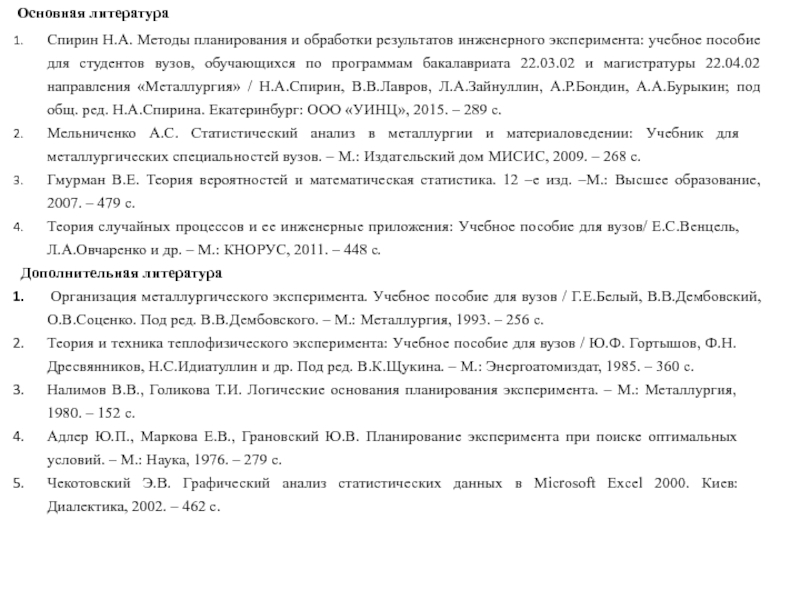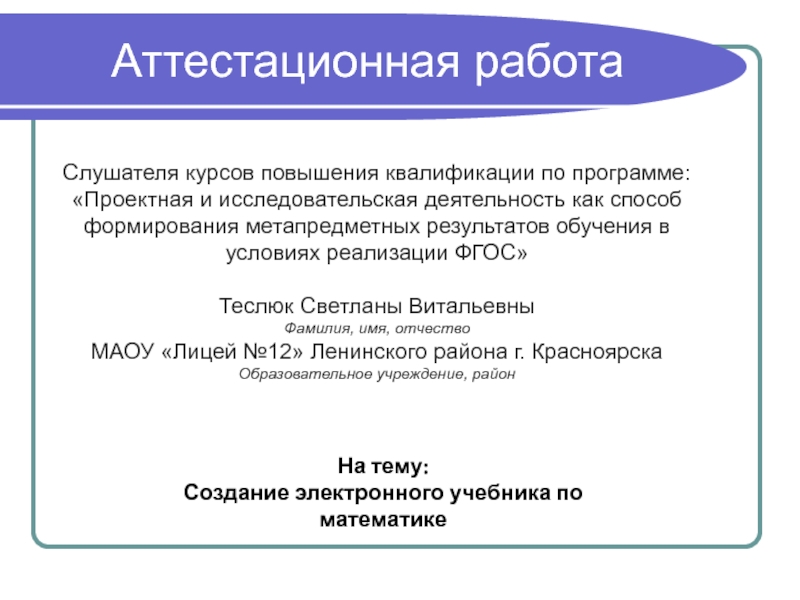- Главная
- Разное
- Дизайн
- Бизнес и предпринимательство
- Аналитика
- Образование
- Развлечения
- Красота и здоровье
- Финансы
- Государство
- Путешествия
- Спорт
- Недвижимость
- Армия
- Графика
- Культурология
- Еда и кулинария
- Лингвистика
- Английский язык
- Астрономия
- Алгебра
- Биология
- География
- Детские презентации
- Информатика
- История
- Литература
- Маркетинг
- Математика
- Медицина
- Менеджмент
- Музыка
- МХК
- Немецкий язык
- ОБЖ
- Обществознание
- Окружающий мир
- Педагогика
- Русский язык
- Технология
- Физика
- Философия
- Химия
- Шаблоны, картинки для презентаций
- Экология
- Экономика
- Юриспруденция
Descriptive statistics. Elementary statistics. Larson. Farber. (Chapter 2) презентация
Содержание
- 1. Descriptive statistics. Elementary statistics. Larson. Farber. (Chapter 2)
- 2. Frequency Distributions 102 124 108 86 103 82
- 3. Decide on the number of classes (For
- 4. 67 - 78 79 -
- 5. Boundaries 66.5 - 78.5
- 6. Frequency Polygon Time
- 7. Relative Frequency Histogram Time on Phone minutes Relative frequency Relative frequency on vertical scale
- 8. Ogive An ogive reports the number
- 9. Stem-and-Leaf Plot 6
- 10. Stem-and-Leaf Plot 6 |7
- 11. Stem-and-Leaf with two lines per stem
- 12. Dotplot 66 76 86 96 106 116
- 13. The 1995 NASA budget (billions of $)
- 14. Pie Chart 5.7/14.3*360o = 143o 5.9/14.3*360o = 149o
- 15. Measures of Central Tendency Mean: The sum
- 16. 2 4
- 17. 2 4 2
- 18. Shapes of Distributions Uniform Symmetric Skewed right
- 19. Descriptive Statistics Closing prices for two stocks
- 20. Range for A = 67 - 56
- 21. -5.5 -5.5
- 22. Population Variance: The sum of the squares
- 23. Population Standard Deviation Population Standard Deviation
- 24. Calculate the measures of variation for Stock
- 25. Summary Population Standard Deviation Sample Variance Sample
- 26. Empiricl Rule 68- 95- 99.7% rule Data
- 27. Using the Empirical Rule The mean value
- 28. Chebychev’s Theorem For k = 3, at
- 29. Chebychev’s Theorem The mean time in a
- 30. Grouped Data 30 Class f
- 31. Grouped Data To approximate the standard deviation
- 32. Quartiles You are managing a store. The
- 33. The data in ranked order (n =
- 34. Box and Whisker Plot A box
- 35. Percentiles Percentiles divide the data into 100
- 36. Percentiles 114.5 falls on or above 25
Слайд 2Frequency Distributions
102 124 108 86 103 82
71 104 112 118 87 95
103 116 85 122 87 100
105
109 99 105 99 101 92
Make a frequency distribution table with five classes.
Minutes Spent on the Phone
Key values:
Minimum value =
Maximum value =
67
125
Слайд 3Decide on the number of classes (For this problem use 5)
Calculate the Class Width
(125 - 67) / 5 = 11.6 Round up to 12
Determine Class Limits
Mark a tally in appropriate class for each data value
Frequency Distributions
78
90
102
114
126
3
5
8
9
5
67
79
91
103
115
Do all lower class limits first.
Слайд 4 67 - 78
79 - 90
91 - 102
103 -114
115
3
5
8
9
5
Midpoint: (lower limit + upper limit) / 2
Relative frequency: class frequency/total frequency
Cumulative frequency: Number of values in that class or in
lower one.
Other Information
Midpoint
Relative
frequency
Cumulative
frequency
72.5
84.5
96.5
108.5
120.5
0.10
0.17
0.27
0.30
0.17
3
8
16
25
30
Слайд 5 Boundaries
66.5 - 78.5
78.5 - 90.5
90.5 - 102.5
102.5
115.5 -126.5
Frequency Histogram
Time on Phone
minutes
f
Слайд 6 Frequency Polygon
Time on Phone
minutes
f
Mark the midpoint at
Слайд 7Relative Frequency Histogram
Time on Phone
minutes
Relative frequency
Relative frequency on vertical scale
Слайд 8Ogive
An ogive reports the number of values in the data set
are less than or equal to the given value, x.
Слайд 9Stem-and-Leaf Plot
6 |
7 |
8 |
9 |
10|
11|
12|
Stem
Leaf
Lowest
102 124 108 86 103 82
2
4
8
6
3
2
Слайд 10Stem-and-Leaf Plot
6 |7
7 |1 8
9 |2 5 7 9 9
10 |0 1 2 3 3 4 5 5 7 8 9
11 |2 6 8
12 |2 4 5
Key: 6 | 7 means 67
Слайд 11Stem-and-Leaf with two lines per stem
6 | 7
7
7 | 8
8 | 2
8 | 5 6 7 7
9 | 2
9 | 5 7 9 9
10 | 0 1 2 3 3 4
10 | 5 5 7 8 9
11 | 2
11 | 6 8
12 |2 4
12 | 5
Key: 6 | 7 means 67
1st line digits 0 1 2 3 4
2nd line digits 5 6 7 8 9
1st line digits 0 1 2 3 4
2nd line digits 5 6 7 8 9
Слайд 13The 1995 NASA budget (billions of $)
divided among 3 categories.
Pie
Used to describe parts of a whole
Central Angle for each segment
Construct a pie chart for the data.
Слайд 15Measures of Central Tendency
Mean: The sum of all data values divided
For a population: For a sample:
Median: The point at which an equal number of values fall above and fall below
Mode: The value with the highest frequency
Слайд 16
2 4 2 0 40 2
Calculate the mean, the median, and the mode
n = 9
Mean:
Median: Sort data in order
0 2 2 2 3 4 4 6 40
The middle value is 3, so the median is 3.
Mode: The mode is 2 since it occurs the most times.
An instructor recorded the average number of absences for his students in one semester. For a random sample the data are:
Слайд 17
2 4 2 0 2 4
Calculate the mean, the median, and the mode
n =8
Mean:
Median: Sort data in order
The middle values are 2 and 3, so the median is 2.5
Mode: The mode is 2 since it occurs the most.
Suppose the student with 40 absences is dropped from the course. Calculate the mean, median and mode of the remaining values. Compare the effect of the change to each type of average.
0 2 2 2 3 4 4 6
Слайд 18Shapes of Distributions
Uniform
Symmetric
Skewed right
Skewed left
Mean > median
Mean < median
Mean =
Слайд 19Descriptive Statistics
Closing prices for two stocks were recorded on ten successive
Mean = 61.5
Median =62
Mode= 67
Mean = 61.5
Median =62
Mode= 67
56 33
56 42
57 48
58 52
61 57
63 67
63 67
67 77
67 82
67 90
Stock A
Stock B
Слайд 20Range for A = 67 - 56 = $11
Range = Maximum
Range for B = 90 - 33 = $57
The range only uses 2 numbers from a data set.
The deviation for each value x is the difference between the value of x and the mean of the data set.
In a population, the deviation for each value x is:x - μ
In a sample, the deviation for each value x is:
Measures of Variation
Слайд 21 -5.5
-5.5
-4.5
-3.5
1.5
1.5
5.5
5.5
5.5
56
56
57
58
61
63
63
67 67 67
Deviations
µ = 61.5
56 - 61.5
56 - 61.5
57 - 61.5
58 - 61.5
∑ ( x - µ) = 0
Stock A
Deviation
The sum of the deviations is always zero.
Слайд 22Population Variance: The sum of the squares of the deviations, divided
Stock A
56 -5.5 30.25
56 -5.5 30.25
57 -4.5 20.25
58 -3.5 12.25
61 -0.5 0.25
63 1.5 2.25
63 1.5 2.25
67 5.5 30.25
67 5.5 30.25
67 5.5 30.25
188.50
Sum of squares
Population Variance
Слайд 23Population Standard Deviation
Population Standard Deviation The square root of the
The population standard deviation is $4.34
Слайд 24Calculate the measures of variation for Stock B
Sample Standard Deviation
To
The sample standard deviation, s is found by taking the
square root of the sample variance.
Слайд 25Summary
Population Standard Deviation
Sample Variance
Sample Standard Deviation
Range = Maximum value - Minimum
Population Variance
Слайд 26Empiricl Rule 68- 95- 99.7% rule
Data with symmetric bell-shaped distribution has
About 68% of the data lies within 1 standard deviation of the mean
About 99.7% of the data lies within 3 standard deviations of the mean
About 95% of the data lies within 2 standard deviations of the mean
68%
Слайд 27Using the Empirical Rule
The mean value of homes on a street
68%
68%
$120 is 1 standard deviation below the mean and $135 thousand is 2 standard deviation above the mean.
68% + 13.5% = 81.5%
So, 81.5% of the homes have a value between $120 and $135 thousand .
68%
Слайд 28Chebychev’s Theorem
For k = 3, at least 1-1/9 = 8/9= 88.9%
For any distribution regardless of shape the portion of data lying within k standard deviations (k >1) of the mean is at least 1 - 1/k2.
μ =6
σ =3.84
For k = 2, at least 1-1/4 = 3/4 or 75% of the data lies within 2 standard deviation of the mean.
Слайд 29Chebychev’s Theorem
The mean time in a women’s 400-meter dash is 52.4
52.4
54.6
56.8
59
50.2
48
45.8
2 standard deviations
At least 75% of the women’s 400- meter dash times will fall between 48 and 56.8 seconds.
Mark a number line in standard deviation units.
Слайд 30Grouped Data
30
Class
f
Midpoint (x)
To approximate the mean of data in
of its class. x = Class midpoint.
x f
2991
Слайд 31Grouped Data
To approximate the standard deviation of data
in a frequency
use x = class midpoint.
739.84
2219.52
231.04
1155.20
10.24
81.92
77.44
696.96
432.64
2163.2
30
6316.8
Слайд 32Quartiles
You are managing a store. The average sale for each of
28 43 48 51 43 30 55 44 48 33 45 37 37 42 27 47 42 23 46 39 20 45 38 19 17 35 45
3 quartiles Q1, Q2 and Q3 divide the data into 4 equal parts.
Q2 is the same as the median.
Q1 is the median of the data below Q2
Q3 is the median of the data above Q2
Слайд 33The data in ranked order (n = 27) are:
17 19 20
43 43 44 45 45 45 46 47 48 48 51 55 .
Quartiles
Median rank (27 +1)/2 = 14. The median = Q2 = 42.
There are 13 values below the median.
Q1 rank= 7. Q1 is 30.
Q3 is rank 7 counting from the last value. Q3 is 45.
The Interquartile Range is Q3 - Q1 = 45 - 30 = 15
Слайд 34Box and Whisker Plot
A box and whisker plot uses 5 key
Q1
Q2 = the median
Q3
Minimum value
Maximum value
30
42
45
17
55
Interquartile Range
Слайд 35Percentiles
Percentiles divide the data into 100 parts. There are 99 percentiles:
A 63nd percentile score indicates that score is greater than or equal to 63% of the scores and less than or equal to 37% of the scores.
P50 = Q2 = the median
P25 = Q1
P75 = Q3
Слайд 36Percentiles
114.5 falls on or above 25 of the 30 values.
25/30
So you can approximate 114 = P83 .
Cumulative distributions can be used to find percentiles.
